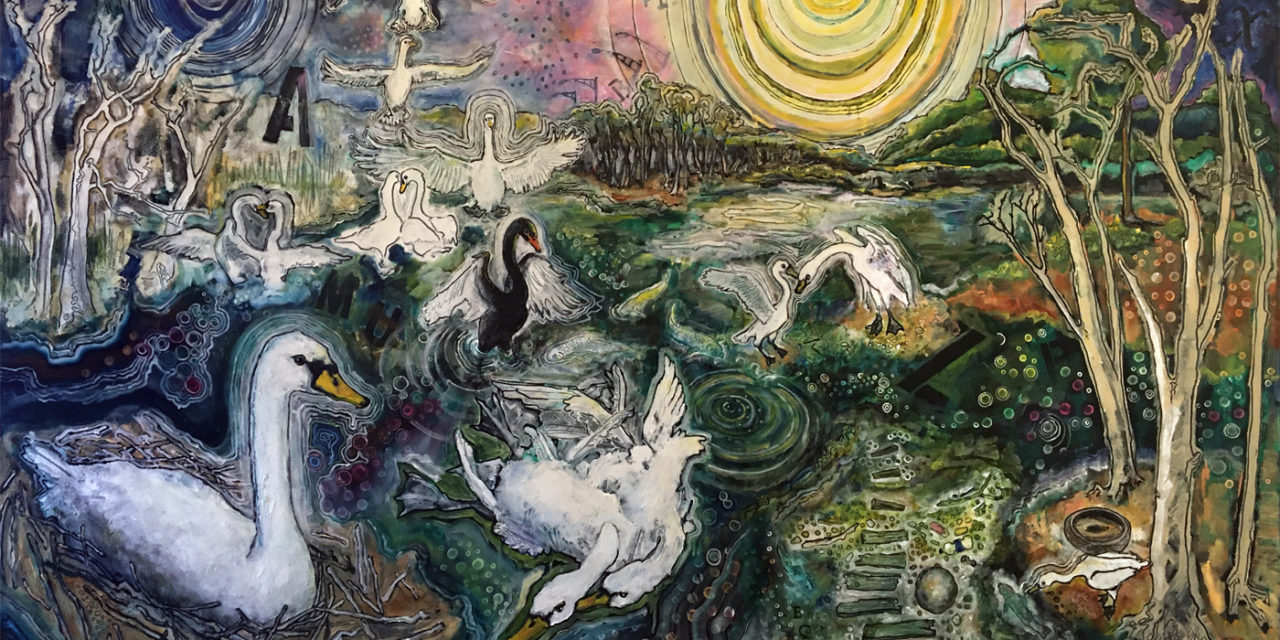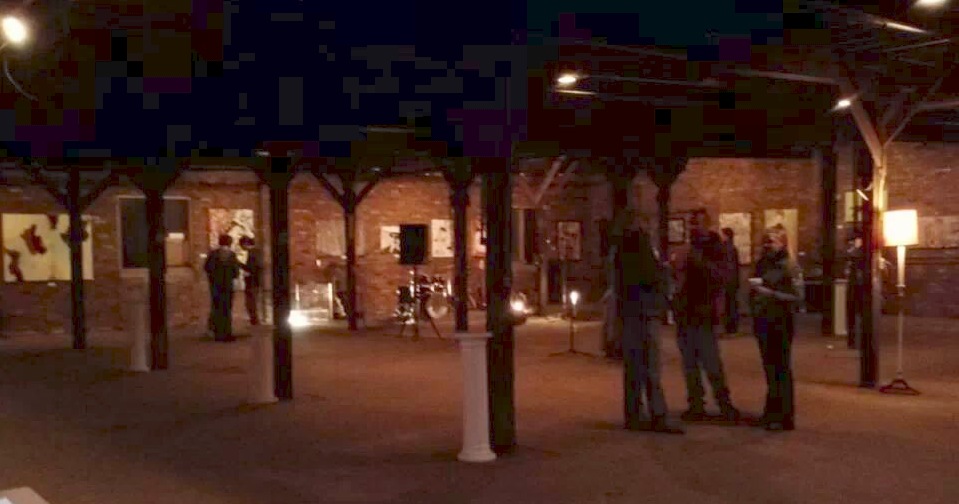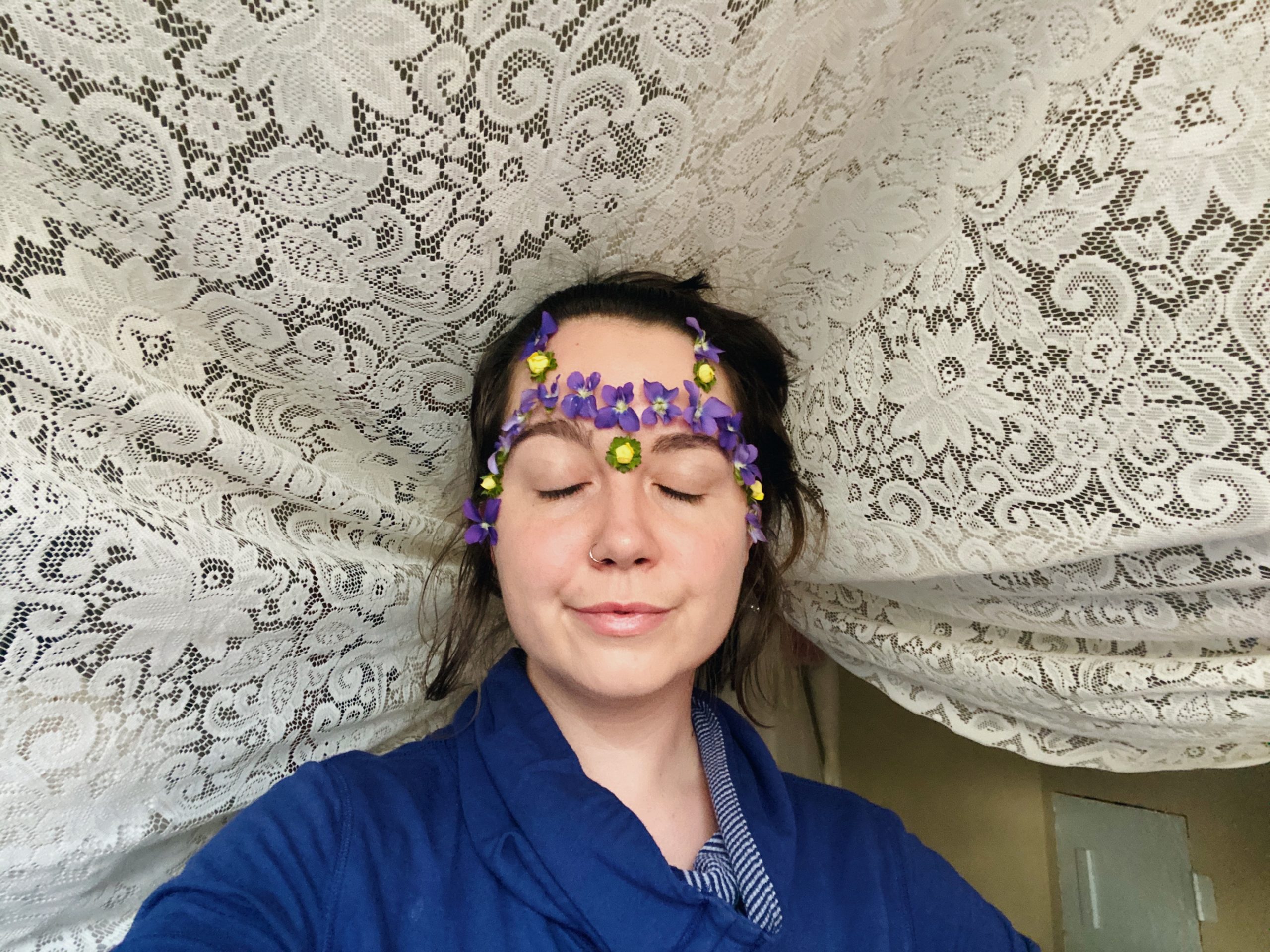Black Swan, oil, 40x60in
Interview by Keith Waits
Entire contents are copyright, © 2020 by Keith Waits. All rights reserved.
Angie Reed Garner is a second-generation self-taught painter (mother Joyce Garner) and the Gallery Director for garner narrative contemporary fine art in NuLu. She has exhibited actively since 1996 with 13 solo shows in the USA, Europe, and the Middle East.
1. You manage garner narrative, but what is the gallery’s status during quarantine?
The first & easy thing we did was reconfigure for a sidewalk gallery open studio in the front windows. Sometimes I paint there, sometimes Will Garner does, and people can walk by at any time and see what we are doing. We have some regulars and it’s a pleasure.
2. What changes, if any, are you implementing for safely re-opening?
It’s overwhelming and it’s taken some work to plot a course. We have both a public health problem and a political problem, and it’s just a lot. But I did finally settle on a strategy and my team is 100% behind it.
The gallery will re-open by appointment only, and stay that way through the end of the election season.
I will gladly make walk-up appointments if the gallery is empty, but guests will always be one person or one contact group at a time. And no receptions.
About a third of the gallery will be closed off to guests, because of a narrow hallway. Will Garner and I can’t staff that space and social distance.
Opening by appointment isn’t to evade any of the requirements for retail. It’s about layering other requirements on top of them, specific to our particular gallery, and to the experience of looking at art.
Like many I’ve had stressful experiences shopping for groceries since the closure. Some people are refusing compliance and not helping out with the social distancing, and that’s hard. But then there are those people without masks deliberately stepping into personal space. I wish this was just my crappy experience, but I’ve heard similar stories from others. As soon as we said everyone has to keep a 6′ distance, we created a whole new way to frighten and endanger folks that’s apparently quite a thrill for some angry and damaged souls. So if we care about reducing transmission risk to ourselves and others, we have to be on guard constantly when out around people.
Anyway, as the supermarket stress increased, I realized it would be important for gallery guests to be able to relax and take in the art without having to watch out for the behavior of other people on any level.
People are deeply divided by personality and politics in how to navigate shared spaces during COVID. I expect this divide to get worse throughout the election season, and for the frustration and acting out to escalate. So I want to run the gallery as a refuge.
An appointment is a significant barrier with negative consequences. It won’t slow down experienced collectors with resources, but it will trouble folks new to visiting galleries and those who are concerned about taking up time and space when they can’t spend. For these reasons I deeply regret locking that gallery door.
A visit to a contemporary art gallery, outside of openings, is probably one of the COVID-safest cultural activities available offline. Guests don’t need to touch anything, and it’s basically a large mostly empty room with things to look at and have thoughts and feelings about. Guests don’t need to interact with gallery staff at any distance, and often they don’t interact unless they really choose to do so.
I’m busy sourcing the same stuff all the other retail business owners are, from masks to thermometers for Will and I to do our own daily temperature checks to hand sanitizer for the door station.
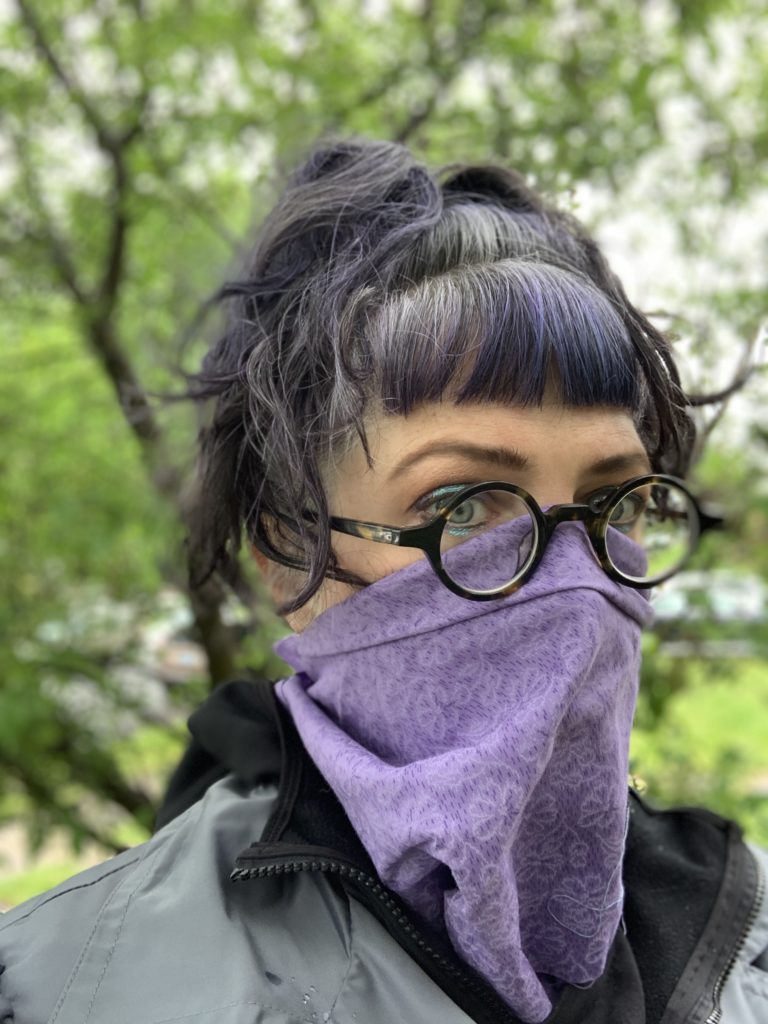
3. Have you been interacting with your artists very much?
Yes. It really matters how old you are and how you are situated and what’s up with your family. We are all in this together… but wow are we in it differently. I’m mostly trying to offer whatever choices I can, and support artists to work out what they want. And it’s hard to know what we as artists should or could want right now from brick and mortar shows.
Before a show, artists are resolving their pieces, maybe grunting out an artist statement, and getting some good photography done for the PR. Now they have to figure out what it means for them to exhibit and to ask or even imply that their public should show up physically to see their work.
Online art experiences of all kinds will clarify what a physical gallery is for. I welcome this.
4. When did you know you were an artist?
By the time I finished college, I was somewhat clear… even if it took another couple years to work the grief process about not being able to be something else with a more conventional & proven path to success. I paid the bills working in mental health (which I still miss), then went full time as an artist.
5. What is your training?
I’ve learned directly from other artists, by getting my eyes on famous paintings in person and reverse-engineering them, and books. I personally decided against art school and it was the right call, though I support that training for people in so many cases.
6. Has self-isolation motivated you to be more productive?
Painting output has stayed the same. And… I’ve been shocked by how beneficial this isolation is, for my general self-care and other projects. Once upon a time I imagined (like everyone else probably) that if only I had more time to myself in a day, I’d get my shit together and make some real progress. Well, it turns out it is true, I did just need more time to myself to get all kinds of stuck things moving again. So what do I do with that?
For a while, maybe longer than we hope, contemporary artwork will be seen from inside COVIDspace and will be answerable to the COVID experience. Artists just had a reset switch hit, like it or not.
I accept this, but it’s not easy. I wish we were focusing this level of intense collective attention and resources on other needs and injustices; now we have to cope with COVID and carry the work forward. So in my head is some kicking and screaming. Which it is my job to work into the paintings.
I had to set aside my canvas in progress when the pandemic hit; that painting was not at all about the pandemic, but it sure is going to be read that way. I found myself misreading my own piece that way, and it got messy and complicated trying to honor my original intent. Maybe in six months I will see how that piece can work just fine with everything we are living through. The pandemic skewed the narrative so, so dark; lighter or more open-ended interpretations suddenly weren’t available.
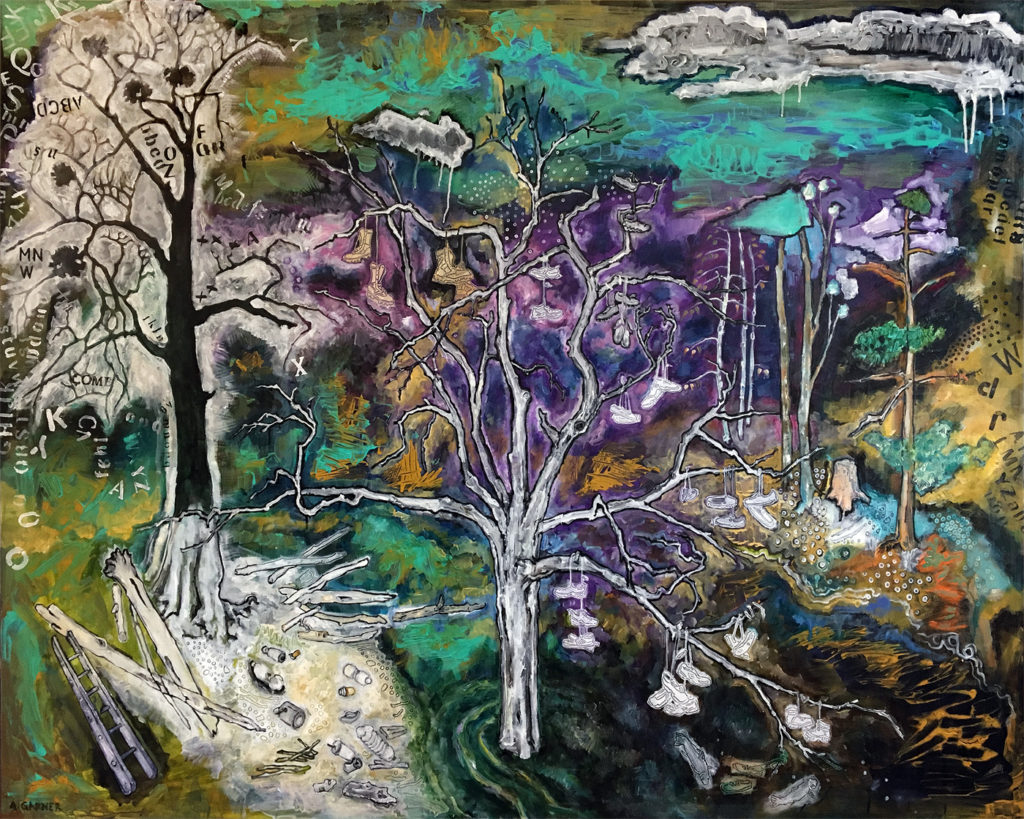
Shoetree, oil, 48x60in
7. Besides Louisville, what other places have you lived and worked?
Portland OR, Berlin, Chicago, Ithaca NY, Lahore PK, Abu Dhabi UAE, three tiny midwest towns.
8. How is working in Louisville different?
We are horrible and we mostly don’t know it. We are awesome and we mostly don’t know it. There are historical causes and conditions for everything and we mostly don’t know what those are either.
The money is less, the quality of life (outside of a global pandemic) for that money is incredible, and the scale of the city feels about perfect. Size-wise it’s the true sweet spot, and I say that as someone who lived through Stumptown becoming “Portlandia.”
I was very intentional about moving back to Louisville. I had other choices, this is what I wanted and prepared for, and I have zero regrets. I struggle with overwork and an over-full life because they’re a lot of opportunities here to get involved and make a difference. But too much deeply meaningful work is not such a bad problem to have.
Maybe because I did my 20s as a young artist in Portland OR, I have a thing for blue city-red state dynamics, I imprinted on them or something. The tensions can be stressful but it’s an interesting, productive kind of stress for artists. So again, Louisville just feels right to me.
9. If you hadn’t become an artist, what would you be doing?
As long as my art practice is strong, I can do a number of other things I also love, and do them well enough that people will pay me to do them, from writing to teaching. But all apparently depends on protecting that painting time. I’ve learned it’s best not to let my brushes collect any dust.
I daydream about a completely private art practice, what it would be like to drop the “artist” and “gallery director” roles, and just do whatever work is left. I probably won’t need to go to that extreme but it is food for thought: what would that work be? That’s always already the work I need to be doing. And nothing else.
10. What music have you been listening to?
I just got over this thing for Sir Sly. I’m all about dance music. If I play any music in my studio, it’s because I want to bring up physical energy. I gave up energy drinks and it was really a thing.
11. What book is on your bedside table now?
For fiction I read fast and the first criterion is how many books are in the series. Second is how intricate and dedicated is the world-building. Once I get into someone’s world, it is nice if I can spend 7-10 books there before I’m forced to move on. I will make do with three books, if I must.
This is a long story about why I can’t even remember the title of what I am reading. The last thing I read where I did truly retain the title was Kameron Hurley’s Bel Dame Apocrypha “bugpunk” trilogy. It was wow.
For nonfiction, it’s probably a Zen text. But I don’t read that stuff at night. It requires my daytime kind of attention.
12. What is the first thing you will do when you can come out of quarantine?
I want to go dancing at Art Sanctuary and hear live jazz at Decca and see some Ethel Loveless burlesque… and go for some standup! And see if anyone’s figured out anything about all this that we can laugh about.
But I can’t figure out how any of this works, before a vaccine and/or good treatment available to everyone. If venue seating is drastically restricted to reduce contacts, I can’t drink 3x as much and can’t pay 3x as much at the door. I can’t ignore the risk to myself and others, just to be there; my people need better from me.
Artists are either stubborn/resilient/resourceful or else they already quit art well before the pandemic. They find some kind of way. They do it, I’m doing it.
garner narrative contemporary fine art
642 E. Market St.
Louisville, KY 40202
(502) 303-7259
garnernarrative@gmail.com
open by appointment. appointments available Wed-Sun, 1-6, for one individual or contact group at a time
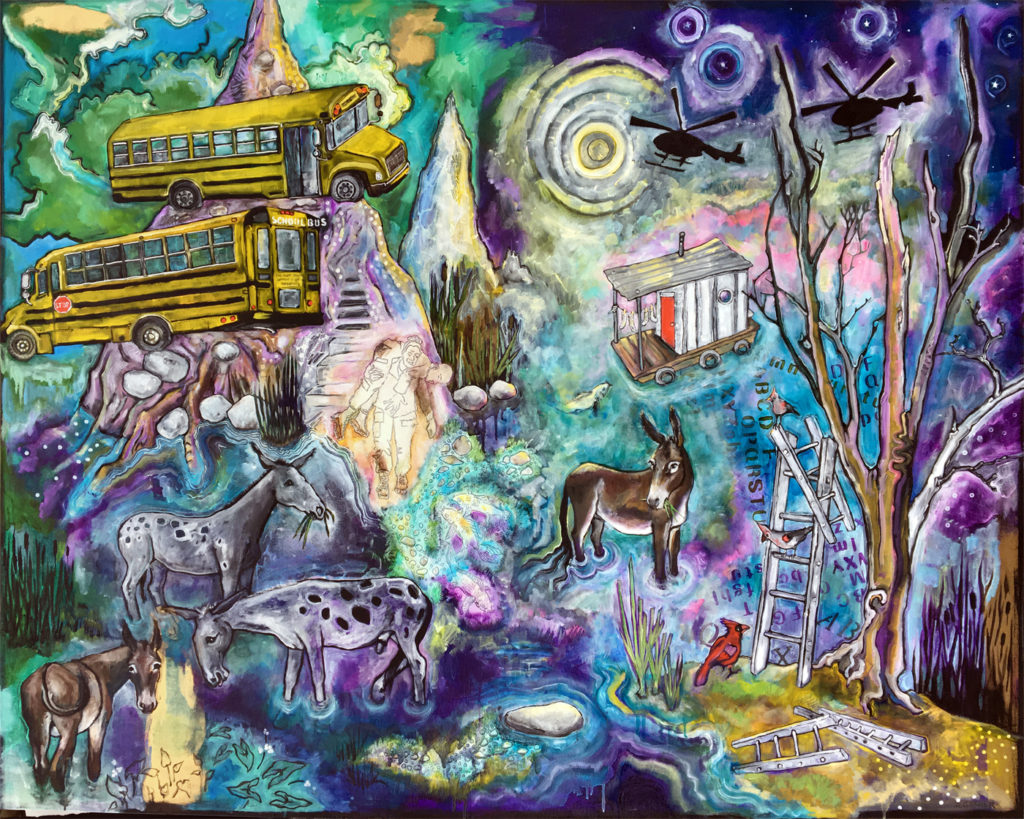
Shantyboat, oil, 48x60in
Keith Waits is a native of Louisville who works at Louisville Visual Art during the days, including being the host of LVA’s Artebella On The Radio on WXOX 97.1 FM / ARTxFM.com, but spends most of his evenings indulging his taste for theatre, music and visual arts. His work has appeared in LEO Weekly, Pure Uncut Candy, TheatreLouisville, and Louisville Mojo. He is now Managing Editor for Arts-Louisville.com.

